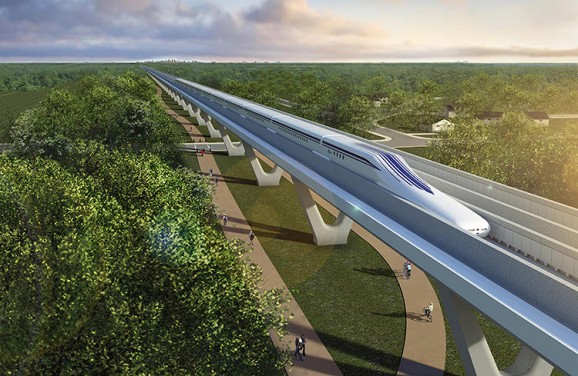300-MPH Bullet Train May Come To The East Coast
This article is more than 2 years old
 For a long time, North Americans have looked with longing and envy at Asia’s high-speed maglev trains, also known as bullet trains. Now it looks like this technology could finally be coming to American shores.
For a long time, North Americans have looked with longing and envy at Asia’s high-speed maglev trains, also known as bullet trains. Now it looks like this technology could finally be coming to American shores.
Japan developed this train system back in the 60s, when we were focused on space technology. Today they have the world’s fastest train, capable of traveling at over 300 miles per hour. Shanghai’s 268 mph train began service in 2004. China has the longest high-speed rail network in the world, with just under 6,000 miles of track for trains that run at speeds of at least 124 mph. South Korea’s got a high-speed rail system, as does most of Europe. Brazil has been working on a maglev system since 2009.
Here in the U.S., we’ve never been all that into train travel. Amtrak has struggled for years now, with the number of stations and routes decreasing and the cost of tickets increases. Amtrak does operate the fastest train in the U.S., though—the Acela Line, which can go up to 150 mph, but averages around 80 because of speed limits. They have at various times announced plans to modernize the Acela line, nearly tripling its speed and reach. The dates for this vary from “by 2040” to “someday,” and the associated costs are in the hundreds of billions.
Let’s forget Amtrak for a minute. There’s a company called The Northeast Maglev (TNEM) based in Washington, D.C. that plans on bringing a superconducting maglev train to the Northeaster Corridor, with a route between New York and D.C., and eventually up to Boston. One vote in its favor is that the company has partnered with the Central Japan Railway Company, which has been developing these trains for over 25 years and operates the popular high-speed line between Tokyo and Osaka.
Maglev trains run on air. It’s the future, remember? Electromagnetic coils on the tracks keep the trains elevated on a cushion of air, and magnets keep the train elevated and electric currents transferred by the coils move the train at high speeds and with almost no friction. Similar projects have been proposed and shot down in the based due to high cost, most of which results from building the rails, especially the tunnels that help trains bypass curves along the way. That’s an unavoidable cost, just the small route between D.C. and Baltimore could cost as much as $10 billion.
So we’ll need the federal government to pony up on this one. I don’t know how likely that is either, but damn, have you ever been to the Northeast? Have you ever tried to drive out here? If so, you’re probably still stuck in traffic. This area is ridiculously congested. And since jetpacks haven’t really caught on and hoverboards have somehow not been invented yet—despite what Back to the Future II promised—we need something else. There’s reason to be hopeful about this project, however. Northeast Maglev CEO Wayne Rogers sums it up, “the concept is different, the sponsorship is different, the routing is different, and the technology is different.” There’s also Elon Musk, whose Hyperloop proposal has people seriously excited about traveling through California in a half-hour.
So here’s hoping this isn’t a pipe dream. But at least I’ve got my bike.












